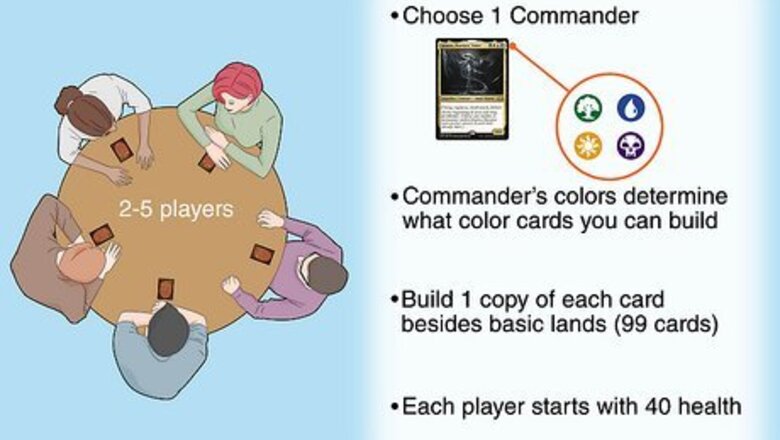
views
- Commander is 100-card singleton format that’s designed to be more playful and laid back than other formats.
- Any legendary creature can be your commander, but every card in your deck must share a color with that creature.
- Unlike regular games of Magic, every player starts with 40 health, although your commander only needs to deal 21 damage to knock someone out.
What is Commander?

Commander is a 2- to 5-player format with unique deck requirements. Commander, also known as EDH (short for Elder Dragon Highlander—the original name of the format), is known for being more casual and enjoyable than some of the more intense formats, like modern or legacy. It was invented by judges who wanted to play something low-key and social after tournaments were over. Here’s how the format works: You choose one commander to lead your deck. A commander can be any legendary creature (so long as the creature isn’t on the banlist). Your commander’s colors (the mana symbols on the card) determine what color cards you can put in your deck. The color identity includes the mana pips in activated abilities (i.e., Tazri, Beacon of Unity counts as a 5-color commander). Build a singleton deck (so only 1 copy of each card besides basic lands) of 99 cards to go with your commander. The 99 cards must share a color with the commander. Gameplay follows standard MTG rules except 2-5 players can play, and everyone starts with 40 health.
Choosing a Commander
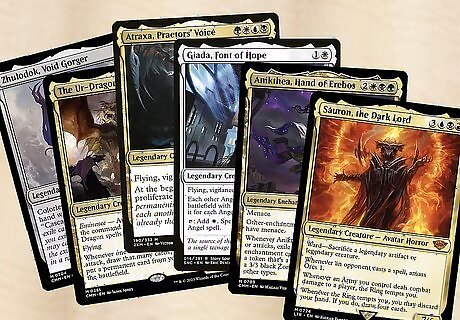
Option #1—Choose your favorite legendary creature. Most MTG players have their pet cards they’ve always wanted to play with. The problem is, most of those really fun cards can’t be put in a deck in traditional formats because they aren’t “competitive” enough for the metagame. This is your chance to pull out that cool legendary creature you never get a chance to play with! Don’t worry about your commander being “underpowered.” Most commander players build decks they think are neat or interesting to play, not hyper-competitive. With that said, if you do ever want to play in competitive commander tournaments, check out the 100 most popular commanders to find a list of phenomenal options. Want to skip deckbuilding altogether? Purchase a preconstructed deck. You can play with one of these right out of the box.
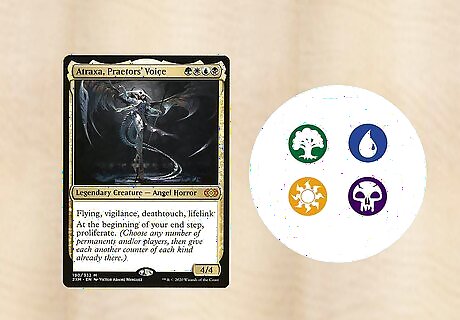
Option #2—Pick a good all-around creature in your favorite colors. Most players have a favorite color or color combination. After all, the 5 colors of Magic are the core design that made the game so popular in the first place. Choose your colors (or color—there’s nothing wrong with playing a monocolor deck!), then select a good all-around commander that matches those colors. For example: Atraxa, Praetors’ Voice, the most popular commander in the game, is just a really good all-around card that lets you play every color except red. If you love green white and enchantments, a commander like Sythis, Harvet’s Hand is perfect! Draw cards and gain life while casting your cards. A lot of players build aggro white decks with Isamaru, Hound of Konda. Just a boring old 2/2 for one white pip!

Option #3—Select a creature with a mechanic you like playing with. Let’s say you really love games where lands matter. You love using your Wrenn and Six to scoop up lands from the graveyard and loop Wasteland, or you really love ramping out with Azusa, Lost But Seeking. You might choose a commander who interacts uniquely with lands, like Soul of Windgrace, or Titania, Protector of Argoth. Other popular mechanics and themes for decks include: Token generation. Go wide with commanders like Brimaz, King of Oreskos or Mondrak, Glory Dominus who can churn out token creatures every turn. Superfriends. A commander like Carth the Lion can help churn out planeswalker after planeswalker to build a league of “superfriends” who work together. Graveyards matter. Commanders like Muldrotha, the Gravetide help pull creatures back into play from the graveyard to build an advantage. Tribal. Build a goblins deck with Krenko, Mob Boss, or build an army of zombies with Liliana, Heretical Healer. Other popular tribes include merfolk, humans, dragons, and angels.
Building Your Deck

Find other creatures that work well with your commander. Unless you’re building something like an Izzet spell-based deck, you probably want around 40 creatures in your deck. Look for creatures that compliment your commander by either helping you cast them, or playing into their goals. Use the official card search engine to find creatures in your colors. Remember, you need a total of 100 cards. 1 is your commander, but the other 99 are totally up to you! For example, if you’re building a deck around Urza, Lord High Artificer, you probably want a ton of cheap artifact creatures you can tap for mana, and then big heavy hitters you can cast with his second ability and all of that mana you generate. There are no hardline rules when it comes to the exact number of given creatures in a deck, so use 40 as a general guideline, not a hard and fast rule.

Look for instants and sorceries that supplement your deck’s goals. Every deck can benefit from spells that get rid of opponents’ creatures, find key pieces of your deck, or draw cards. Depending on what your deck is trying to do, you may want 10-20 instants, sorceries, enchantments, or artifacts. Take advantage of cheap removal spells if you’re in colors other than blue. Cards like Path to Exile and Fatal Push are almost always worth a few slots. You may want up to 40 spells if you’re running a spellslinger deck with a commander like Niv-Mizzet, Parun.

Choose 38-40 lands to help you cast your cards. Failing to include enough lands to cast your spells is one of the biggest mistakes deckbuilders make. Since you want 3-4 lands in your opening hand and you want to play one land every turn, you need at least 36 lands. However, most players run 38-40 so they don’t miss land drops. Basic lands are the only exception to the singleton rules for Commander. You can run any number of basic lands. Some lands can be surprisingly expensive. This is mainly because everyone wants and needs the same lands. Don’t worry about including the revised duals, fetchlands, triomes, and other pricey buys if you want to save some cash. Check out the comprehensive list of dual lands to see what kind of lands exist for your color combination.
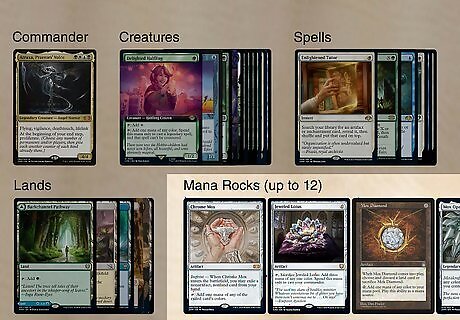
Add up to 12 mana rocks depending on how much ramp you want. In MTG, ramp refers to anything that helps you generate more mana on future turns. While you can ramp in the form of creatures like Elvish Mystic or Devoted Druid, most decks benefit from mana rocks—artifacts that help tap for mana—because they’re harder to remove and easier to cast. You generally want more mana rocks the bigger the creatures in your deck are, and fewer mana rocks the more aggressive your deck is. Sol Ring is the single most popular card in Commander. Every deck wants this rock!
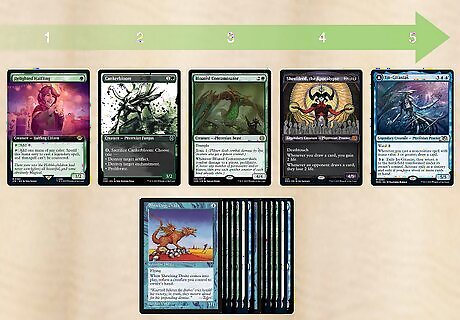
Fine-tune the list to create a curve that looks right to you. The curve of a deck refers to the converted mana costs of all of your cards. In general, you want a smooth curve of 1-, 2-, 3-. 4-. 5-, and 6-mana cost cards so that you have things you can play at every point in the game. If you play nothing but tiny creatures, you’ll be casting underpowered creatures when everyone else is playing huge haymakers. On the opposite end, if you only put big, beefy creatures in your deck, you won’t be able to play anything for the first 3-4 turns of the game.
Playing the Game

Set your commander in the command zone. Before the game starts, put your commander in the “command zone.” You can cast your commander to the battlefield from the command zone at any time you’d play a creature. If your commander ever dies, it goes to the command zone again—not the graveyard. You can recast your commander after they’ve died by paying 2 additional colorless mana for each time they’ve died. So, a 3cmc commander will cost 5cmc the first time they die, 7cmc the second time they die, etc. Note: if you have a commander who has the Eminence ability, they’ll impact the board from the command zone as if they were in play.

Choose someone to play first. Commander is more of a social game than other formats, so you can use whatever method you’d like to choose who plays first. Traditionally, each player rolls dice and whoever rolls the highest number goes first. You and your playgroup can use whatever method you’d like, though.

Draw 7 cards and resolve any mulligans. Sit down with your friends and shuffle your deck up. Lay it face down and draw the top 7 cards. If you don’t like your hand, mulligan it. Shuffle, and draw 7 new cards. If you’re happy with your new hand, put 1 card at the bottom of your library. You can mulligan any number of times, although you do need to put an additional card at the bottom of the library for each new mulligan. A good opening hand should have a combination of lands, early plays, and payoffs. If you find yourself mulliganing often, it’s a sign your deck’s curve or land count are off.

Take turns going clockwise playing MTG as normal. The individual components of each turn are identical in every MTG format, and Commander is no different. You play lands, creatures, and sorceries during your main phases, announce attackers, pass your turn, and play the exact same way you’d play a normal game of Magic. Remember the phases of the turn: Untap: Untap all of the lands, creatures, and permanents on your board. Upkeep: Pay any “upkeep” costs. Normally, nothing happens here. Draw: Draw your card for the turn. Main: Play lands, permanents, or spells. Pre-combat: Announce attackers & blockers. Combat: Apply damage, put dead creatures in the graveyard, and subtract HP. Main II: Play lands, permanents, or spells. End step: Pass your turn.
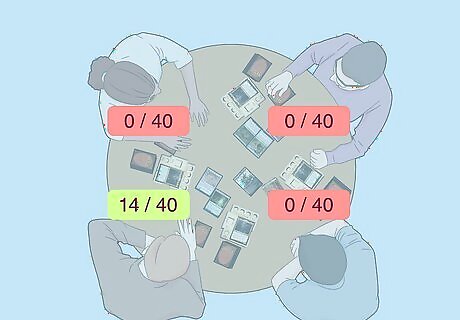
Continue playing until you die or you’re the last one standing! There are two types of damage in Commander. Every player starts with 40 HP and when someone is hit by a non-commander creature, you subtract from this pool. However, you also have commander damage. If any player takes 21 points of damage from a commander creature specifically they die. Multiplayer games continue until there’s one player left standing!
Finding Games
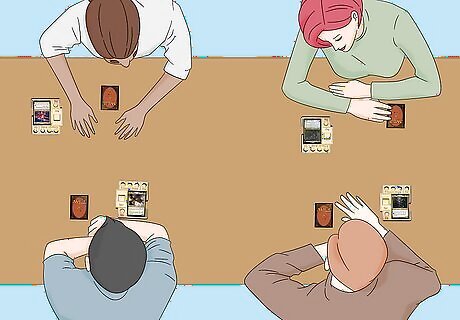
Play in-person with friends or at your local game shop. Contact your local game shop and ask them when they host Commander night (every MTG shop will have one). Show up and pay the $5-10 to enter and wait for the matches to be set up. You’ll be paired with 3 other players to enjoy some Commander gameplay! Once you find a crowd who you get along with, ask them if they’d like to form a regular playgroup. You can always just play casually at the kitchen table with 1-4 friends if you have some friends who want to get into MTG.
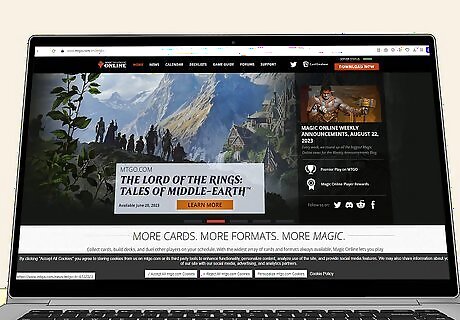
Play Commander online with MTGO. MTGO, aka Magic: The Gathering Online, is the original online platform for MTG. You have to buy cards the same way you would IRL, but they’re much cheaper. On top of that, you can play with other players whenever you want! MTGO is also the program you’ll need if you ever want to play Modern, which is the second most popular format of Magic.
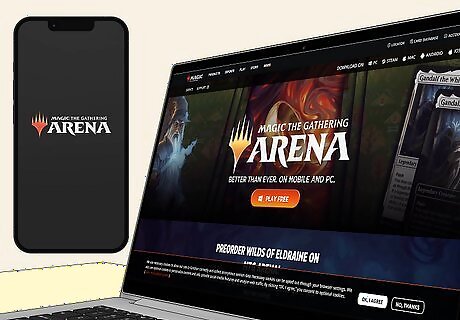
Play Brawl on Magic Arena for a free alternative. Magic Arena is a newer online program for Magic: The Gathering. It’s free to play (although there are some in-game purchases), and while it doesn’t offer Commander, it does have the Brawl format. This is like Commander, except it’s 1v1 and you only build a 60-card deck. You also only have access to newer cards. While Magic Arena is free, you can’t purchase individual cards the way you can on MTGO. As a result, it may take a while to earn the in-game currency you need to build the deck you want.




















Comments
0 comment